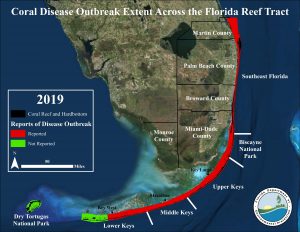By Mike Loizzo
GAINESVILLE, Fla. — In 2014, an unprecedented disease outbreak affecting the soft tissue of many species of stony coral was first detected in Florida. Since then, stony coral tissue loss disease has been identified in nearly half of the 45 coral species on the Florida Reef Tract, the only living barrier reef along the continental United States.
Researchers have set their focus on determining the cause and stopping the spread of this outbreak.
This includes a team of scientists from the University of Florida, Smithsonian Marine Station and Oregon State University, whose recent research examined changes in the microbiomes of coral infected with stony coral tissue loss disease (SCTLD).

Like gut bacteria in the human body, coral tissue contains an array of microbes, some of which do not share a positive relationship with their host. The study investigated the microorganisms associated with diseased coral lesions.
“The DNA analysis showed five unique sequences of bacteria that were associated with the disease on three of the four coral species we tested,” said Julie Meyer, the lead author of the study and an assistant professor in the UF/IFAS department of soil and water sciences. “The diseased tissue also had increased abundances of several groups of bacteria which are known to feed on decaying matter.”
For this study, infected coral colonies off the shore of Fort Lauderdale and in the Middle Florida Keys near Long Key Bridge were sampled in the field. For each colony infected with the disease, researchers collected samples at the lesion, at the first row of healthy-looking polyps adjacent to the lesion, and as far away as possible from the lesion in apparently healthy tissue. Additionally, they sampled healthy neighboring corals, when available. At the Middle Keys location, almost all of the targeted coral species were infected, emphasizing the impact of the outbreak.
“This work is an important step toward understanding bacteria involved in coral disease progression and changes in the microbial communities in corals that are affected by this devastating tissue loss disease,” said Valerie Paul, director of the Smithsonian Marine Station in Fort Pierce, Fla., and one of the study’s co-authors.

But Meyer cautioned that more work is needed. While they were able to identify bacteria on the diseased colonies, it is not evidence those are causing SCTLD. Another possibility is that there is a “keystone pathogen,” which disrupts the microbiome and makes the coral more susceptible to disease. The identified disease-associated bacteria could also be opportunistic, causing secondary infections in corals that are already dying.
“Our group has also shown that infections of SCTLD can be treated with antibiotics, supporting the idea that the disease is caused by bacteria,” Meyer said. “Our next step involves looking at the changes in microbiomes at the first signs of infection under controlled laboratory conditions. For that experiment, we are sequencing all of the genetic information in the samples, which may let us know if viruses are also involved in this disease.”
Tips for preventing the spread of SCTLD:
- If you are SCUBA diving on reefs impacted by the outbreak, be sure to decontaminate your gear after use to prevent the spread of infectious agents. Guidelines are available from the Florida Keys National Marine Sanctuary (https://floridakeys.noaa.gov/coral-disease/citizen-participation.html).
- Anchor boats well away from coral colonies
- Avoid any direct contact with corals
The research was supported by funding from the National Science Foundation and the U.S. Environmental Protection Agency. The findings were published in the journal Frontiers in Microbiology. Click here for the full article.
-30-
The mission of the University of Florida Institute of Food and Agricultural Sciences is to develop knowledge relevant to agricultural, human and natural resources and to make that knowledge available to sustain and enhance the quality of human life. With more than a dozen research facilities, 67 county Extension offices, and award-winning students and faculty in the UF College of Agricultural and Life Sciences, UF/IFAS works to bring science-based solutions to the state’s agricultural and natural resources industries, and all Florida residents. Visit the UF/IFAS website at ifas.ufl.edu and follow us on social media.
 0
0
